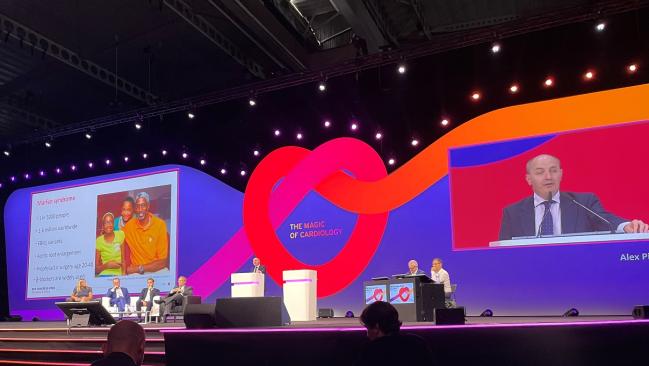ARBs Halve Rate of Aortic Root Enlargement in Marfan: Meta-analysis
ARB effects were roughly similar to those of beta-blockers, and the two seem to act independently, the MTT Collaboration says.

BARCELONA, Spain—(UPDATED) In patients with Marfan syndrome, both angiotensin receptor blockers (ARBs) as well as beta-blockers reduce the rate of aortic enlargement by roughly half compared with placebo, and their effects appear to be independent of one another, a new patient-level meta-analysis suggests.
“Patients and doctors should think about [using] both medications to get the benefits of both,” said Alex Pitcher, BMBCh, DPhil (University of Oxford, England), here at the European Society of Cardiology Congress 2022.
The results from the Marfan Treatment Trialists’ (MTT) Collaboration represent the best evidence to date that these widely available, low-cost medications can help the roughly 1 million people worldwide who suffer from this rare syndrome that can cause fatal aortic dissection if not identified and treated, he said.
Results of the MTT analysis were published simultaneously in the Lancet.
Marfan syndrome is a genetic disorder usually caused by a variant in the fibrillin-1 gene, and results in the progressive enlargement of the aortic root. People affected typically are tall and thin, with elongated limbs and hypermobile joints, and they face a risk of aortic dissections approximately 200 times greater than that of the general population, said Pitcher.
The only other evidence in support of these agents in Marfan comes from small, underpowered trials and observational studies.
Power in Numbers
For their meta-analysis, Pitcher and colleagues identified 10 eligible trials of ARBs versus placebo or beta-blocker, of which seven met criteria for inclusion, representing a total of 1,442 patients. Four trials (676 patients) compared an ARB to placebo, while the remainder compared ARBs to beta blockade. For the MTT analysis, the primary endpoint was the annual rate of change of body surface area-adjusted aortic root dimension Z score, measured at the sinus of Valsalva.
We think that guideline panels should be looking at this data and certainly reconsider. Alex Pitcher
Over a median follow-up of 3 years, patients randomized to an ARB had a mean annual increase in aortic root Z score of 0.07, as compared with 0.13 in patients taking a placebo, translating to a mean absolute difference of -0.07 (P = 0.012).
In patients randomized to an ARB versus beta-blocker, the annual change in the aortic root Z score was similar in the two groups: annual increase -0.08 in ARB groups versus -0.11 in the beta-blocker group, a mean absolute difference 0.03 with no significant difference in the magnitude of those effects. By indirect analysis, the difference in annual change in the aortic root Z score between beta-blockers and placebo was -0.09, MTT investigators concluded.
“There are now two medications with proven benefit for patients with Marfan syndrome,” Pitcher told journalists at a press conference yesterday. “They work separately or together, they are widely available and low cost, and they would be expected to delay the time to surgery or to tearing of the aorta if taken for a number of years.”
As such, he continued, “the message for the general public could be, if you suspect you or a relative has Marfan syndrome, you should get diagnosed because there are powerful, proven treatments, both medicines and operations, that could be lifesaving.”
Guidelines, Take Note
Large, adequately powered randomized trials are just not feasible with this rare condition, Pitcher noted. As such, this independent patient-level meta-analysis represents the best evidence to date supporting a role for both agents in the management of this lethal condition.
To TCTMD, Pitcher noted that current guidelines generally recommend beta-blockers, “but they are not class 1 recommendations,” due to the very limited evidence base. “We think that guideline panels should be looking at this data and certainly reconsider,” he said.
To date there has only been one small randomized, controlled trial of beta-blockers versus placebo, and a range of observational studies, Pitcher noted. “I think what this meta-analysis does is add very substantially to the certainty with which doctors can have discussions with patients. ARBs and beta-blockers are some of the most widely used medications in the world,” he continued.
“Of course, not every patient is going to be able to tolerate them, some may have side effects,” Pitcher said. “But we certainly think, given the threatening nature of this condition in terms of life-threating complications, we certainly think that there need to be very compelling reasons for not prescribing or at least considering these medications for Marfan syndrome.”
Roland van Kimmenade, MD, PhD (Radboud University Medical Centre, Nijmegen, the Netherlands), discussing the results in today’s Hot Line session, pointed to one of the prespecified subgroup analyses presented by Pitcher today showing that the effects of ARBs were particularly large in patients who were carriers of pathogenic variants in fibrillin-1 compared with those without such variants.
“This is very interesting, because it means that the effect is not just on blood pressure but is probably an effect of an inhibition between the interaction of RAS system and the TGF-beta pathway, and maybe this can help us better discriminate which patients benefit more from ARB therapy,” he said.
During his presentation, van Kimmenade noted that the earliest studies into aortic dissection in Marfan syndrome were done in mouse models and turkeys—turkeys being the only species other than humans that experience spontaneous aortic dissection.
“But humans are not turkeys nor mutated mice—and the data we saw in animal studies has never been translated into humans,” he said. “We still need to look for further optimization of therapy for patients with Marfan syndrome and in the end, the prescription pencil does not replace the surgical knife; however, it can postpone the surgery.”
Van Kimmenade noted that many of the earlier studies, by “brilliant” investigators, nevertheless showed the opposite of what this pooled analysis concluded. “So one of the other conclusions is that sharing is caring, but data sharing is ultimate health-caring. I think the group should be complimented for stepping over their own papers and their own conclusions to look again at patient-level data to see how we can better help our Marfan patients,” he said.
Note: When originally published, this story incorrectly referred to an interaction between the RAS system and beta-blockers. Dr. van Kimmenade was in fact referring to an interaction between the RAS system and TGF-beta.
Shelley Wood is the Editor-in-Chief of TCTMD and the Editorial Director at CRF. She did her undergraduate degree at McGill…
Read Full BioSources
Pitcher A, Spata E, Emberson J, et al. Angiotensin receptor blockers and β blockers in Marfan syndrome: an individual patient data meta-analysis of randomised trials. Lancet. 2022;Epub ahead of print.
Disclosures
- Pitcher reports having no relevant conflicts of interest.





Comments